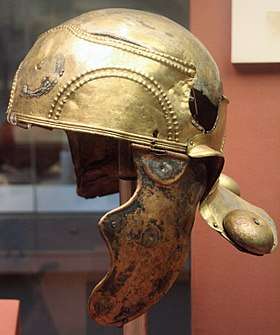Witcham Gravel helmet
| Witcham Gravel helmet | |
|---|---|
 Witcham Gravel helmet | |
| Material | Iron, tin, copper alloy |
| Created | 1st century AD |
| Discovered |
c. 1870s Witcham Gravel, Cambridgeshire |
| Present location | British Museum |
| Registration | 1891,1117.1 |
The Witcham Gravel helmet is a Roman auxiliary cavalry helmet from the first century AD.[1] The decorative copper alloy casing, parts of which are tinned, is all that remains; an iron core originally fit under the casing, but has now corroded away.[2] The helmet's distinctive feature is the presence of three bosses, out of an original six, that decorate the exterior.[3] No other Roman helmet is known to have such a feature.[4]
The helmet was discovered during peat digging in the parish of Witcham, Cambridgeshire, perhaps during the 1870s, and was first exhibited in 1877.[5] The British Museum purchased it in 1891.[6] As of 2018 it is on view in Room 49.[7]
Description
The helmet primarily comprises eight components: a skull cap, a brow piece, an occiput, a neck guard, two raised ear protectors, and two cheek guards, of which one remains.[2] The surviving pieces are made of copper alloy;[2] the cap, neck guard, and cheek guards were tinned, creating the appearance of a gold band surrounding a silver helmet.[8] Originally they were attached to an iron core by two rivets on either side, six along the neck guard, and one split pin at front and at back, but the iron now remains only as corrosion.[2]
The surviving pieces of the helmet are almost entirely decorative, and would have imparted very little protection by themselves.[9] They are made of thin metal, proving an easy medium for repoussé work.[9] Four semicircular designs were made with repoussé punch marks, two each on the brow piece and the occiput.[9] Lines of repoussé work were also punched across the join between the neck guard and occiput,[10] and at the top of the occiput and brow piece. The unique feature of the helmet, not known on any other Roman helmet, is the presence of three hollow bosses on the neck guard.[3] These were both soldered and riveted on; the latter attachments would also help hold the copper alloy components to the iron core.[11] Circular remnants suggest that other bosses were placed above each ear, and over the split pin at the front.[12] Five small bosses were likewise riveted to the ornate cheek guards, already featuring repoussage depicting naturalistic ears.[13] None of these bosses survive, although their impressions remain.[14]
The helmet would have also had a crest.[15] Markings at the apex of the skull cap indicate the former presence of a crest box, 20.5 centimetres (8.1 in) long by 2.3 centimetres (0.91 in) wide, joined by six rivets: two each at the front, centre, and back.[16] The box would have been made of organic materials such as wood filled with horsehair, and has since decayed.[11]
Discovery
The helmet was discovered, perhaps in the 1870s,[1] during peat digging in Witcham Gravel.[2] The exact place where it was found is unclear, although it was said to have been found "at a depth of about four feet";[17] at the time Witcham Gravel was a parish of about 389 acres, a significant amount of which was covered by fens.[18] By 1877 the helmet was in the possession of Thomas Maylin Vipan, and on 17 May it was exhibited to the Society of Antiquaries of London by Augustus Wollaston Franks.[2][5] In June 1880 the helmet was again loaned, this time to the Royal Archaeological Institute, which exhibited it in a two-week long "Exhibition of helmets and mail."[2][19] Vipan died on 23 August 1891, and that November the British Museum bought the helmet from the Rollin & Feuardent auction house, who sold it on instructions from Vipan's estate.
References
- 1 2 Kaminski & Sim 2014, p. 79.
- 1 2 3 4 5 6 7 Kaminski & Sim 2014, p. 69.
- 1 2 Kaminski & Sim 2014, pp. 69, 71, 75.
- ↑ Kaminski & Sim 2014, pp. 69, 75.
- 1 2 Society of Antiquaries 1877, pp. 230–231.
- ↑ Kaminski & Sim 2014, p. 76.
- ↑ British Museum helmet.
- ↑ Kaminski & Sim 2014, p. 75.
- 1 2 3 Kaminski & Sim 2014, p. 70.
- ↑ Kaminski & Sim 2014, p. 72.
- 1 2 Kaminski & Sim 2014, p. 71.
- ↑ Kaminski & Sim 2014, pp. 69–70, 75.
- ↑ Kaminski & Sim 2014, pp. 72–73.
- ↑ Kaminski & Sim 2014, p. 73.
- ↑ Kaminski & Sim 2014, pp. 81.
- ↑ Kaminski & Sim 2014, pp. 71, 74.
- ↑ Society of Antiquaries 1877, p. 231.
- ↑ Kaminski & Sim 2014, pp. 75–76.
- ↑ Archaeological Journal 1880, pp. 455, 463–464.
Bibliography
- "Catalogue of the Exhibition of Ancient Helmets and Examples of Mail" (PDF). The Archaeological Journal. Royal Archaeological Institute. XXXVII: 455–594. 1880.

- "helmet". The British Museum Collection Online. The British Museum. Retrieved 14 November 2017.

- Kaminski, Jaime & Sim, David (2014). "The production and deposition of the Witcham Gravel Helmet" (PDF). Proceedings of the Cambridge Antiquarian Society. Cambridge Antiquarian Society. CIII: 69–82.

- "Thursday, May 17th, 1877". Proceedings of the Society of Antiquaries of London. 2nd series. Society of Antiquaries. VII: 225–235. 1877.
